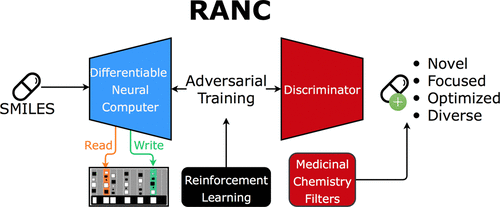当前位置:
X-MOL 学术
›
J. Chem. Inf. Model.
›
论文详情
Our official English website, www.x-mol.net, welcomes your
feedback! (Note: you will need to create a separate account there.)
Reinforced Adversarial Neural Computer for de Novo Molecular Design
Journal of Chemical Information and Modeling ( IF 5.6 ) Pub Date : 2018-05-15 00:00:00 , DOI: 10.1021/acs.jcim.7b00690 Evgeny Putin 1, 2 , Arip Asadulaev 2 , Yan Ivanenkov 1, 3, 4 , Vladimir Aladinskiy 1, 3 , Benjamin Sanchez-Lengeling 5 , Alán Aspuru-Guzik 5, 6 , Alex Zhavoronkov 1, 7
Journal of Chemical Information and Modeling ( IF 5.6 ) Pub Date : 2018-05-15 00:00:00 , DOI: 10.1021/acs.jcim.7b00690 Evgeny Putin 1, 2 , Arip Asadulaev 2 , Yan Ivanenkov 1, 3, 4 , Vladimir Aladinskiy 1, 3 , Benjamin Sanchez-Lengeling 5 , Alán Aspuru-Guzik 5, 6 , Alex Zhavoronkov 1, 7
Affiliation

|
In silico modeling is a crucial milestone in modern drug design and development. Although computer-aided approaches in this field are well-studied, the application of deep learning methods in this research area is at the beginning. In this work, we present an original deep neural network (DNN) architecture named RANC (Reinforced Adversarial Neural Computer) for the de novo design of novel small-molecule organic structures based on the generative adversarial network (GAN) paradigm and reinforcement learning (RL). As a generator RANC uses a differentiable neural computer (DNC), a category of neural networks, with increased generation capabilities due to the addition of an explicit memory bank, which can mitigate common problems found in adversarial settings. The comparative results have shown that RANC trained on the SMILES string representation of the molecules outperforms its first DNN-based counterpart ORGANIC by several metrics relevant to drug discovery: the number of unique structures, passing medicinal chemistry filters (MCFs), Muegge criteria, and high QED scores. RANC is able to generate structures that match the distributions of the key chemical features/descriptors (e.g., MW, logP, TPSA) and lengths of the SMILES strings in the training data set. Therefore, RANC can be reasonably regarded as a promising starting point to develop novel molecules with activity against different biological targets or pathways. In addition, this approach allows scientists to save time and covers a broad chemical space populated with novel and diverse compounds.
中文翻译:

用于新分子设计的增强型对抗神经计算机
计算机模拟是现代药物设计和开发中的关键里程碑。尽管已经对该领域中的计算机辅助方法进行了深入研究,但深度学习方法在该研究领域中的应用才刚刚开始。在这项工作中,我们提出了一种从头开始的名为RANC(强化对抗神经计算机)的原始深层神经网络(DNN)架构。生成对抗网络(GAN)范式和强化学习(RL)的新型小分子有机结构的设计。作为生成器,RANC使用可微分神经计算机(DNC),这是一种神经网络,由于添加了显式内存库而具有增强的生成能力,可以缓解对抗性设置中的常见问题。比较结果表明,在分子的SMILES字符串表示形式上进行训练的RANC在与药物发现有关的几个指标上优于其首个基于DNN的对应物ORGANIC:独特结构的数量,通过药物化学过滤器(MCF),Muegge标准和高QED分数。RANC能够生成与关键化学特征/描述符(例如MW,logP,TPSA)和训练数据集中SMILES字符串的长度。因此,RANC可以合理地视为开发具有针对不同生物学靶标或途径的活性的新型分子的有前途的起点。此外,这种方法可以使科学家节省时间,并覆盖由新颖多样的化合物组成的广阔化学空间。
更新日期:2018-05-15
中文翻译:

用于新分子设计的增强型对抗神经计算机
计算机模拟是现代药物设计和开发中的关键里程碑。尽管已经对该领域中的计算机辅助方法进行了深入研究,但深度学习方法在该研究领域中的应用才刚刚开始。在这项工作中,我们提出了一种从头开始的名为RANC(强化对抗神经计算机)的原始深层神经网络(DNN)架构。生成对抗网络(GAN)范式和强化学习(RL)的新型小分子有机结构的设计。作为生成器,RANC使用可微分神经计算机(DNC),这是一种神经网络,由于添加了显式内存库而具有增强的生成能力,可以缓解对抗性设置中的常见问题。比较结果表明,在分子的SMILES字符串表示形式上进行训练的RANC在与药物发现有关的几个指标上优于其首个基于DNN的对应物ORGANIC:独特结构的数量,通过药物化学过滤器(MCF),Muegge标准和高QED分数。RANC能够生成与关键化学特征/描述符(例如MW,logP,TPSA)和训练数据集中SMILES字符串的长度。因此,RANC可以合理地视为开发具有针对不同生物学靶标或途径的活性的新型分子的有前途的起点。此外,这种方法可以使科学家节省时间,并覆盖由新颖多样的化合物组成的广阔化学空间。











































 京公网安备 11010802027423号
京公网安备 11010802027423号